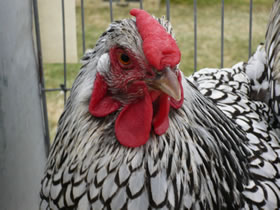 Poultry is a collective term used to describe domesticated birds such as chicken, ducks, geese, turkeys and others. These are mainly used by humans for production and exhibition purposes but some also make excellent pets.
Poultry is a collective term used to describe domesticated birds such as chicken, ducks, geese, turkeys and others. These are mainly used by humans for production and exhibition purposes but some also make excellent pets.
Like all birds, poultry are, too, susceptible to disease. Disease is very common among poultry, especially those used in the farming industry. While it may be impossible or impractical to check individuals for symptoms of disease in a flock of thousands, the effect of disease on a flock can be detrimental to production. Additionally, and most importantly, disease may be an indicator of overall poor welfare.
The ability to recognise a diseased individual early on is therefore very important both for this individual’s welfare and for the health of the entire flock. Here are a few of the most common symptoms of disease in poultry:
Eyes
The eyes of a healthy bird should be clear and bright. Lesions, inflammation or runny discharge may all be signs of an ill bird. For example, inflamed, runny eyes could indicate that the bird is suffering from respiratory disease.
Nose
Similarly, the nostrils of a healthy bird should be clear, dry and open. A healthy bird should breathe with its beak closed. Nasal discharge and gasping for air could indicate the existence of e.g. Infectious Laryngotracheitis.
Wings and feathers
Droopy wings can sometimes be indicative of illnesses such as Ulcerative Enteritis, Blackhead disease and Corona Virus Infection, among others.
Healthy birds have bright, well-groomed feathers with few or no bald patches on their skin. In large flocks, feather loss may sometimes be due to extensive feather pecking or pulling among individuals. Feather loss may also occur due to moulting. However, feather loss may often be due to inadequate nutrition or parasitic infections.
Diarrhoea
Diarrhoea in poultry could be indicative of a host of viral and bacterial diseases, kidney damage and, very commonly, coccidiosis.
Ataxia
Ataxia is the inability to coordinate the muscles of the body during voluntary movements such as walking. Ataxia in poultry could be a sign of Avian Encephalomyelitis, Marek’s disease or Duck plague, among others.
Abnormal behaviour
The display of normal, species-specific behaviours is usually a sign of good health and welfare. Any deviation from normal behavioural patterns could indicate that something is wrong with the bird. Often, abnormal behaviour may mean that a bird is ill.
In poultry, withdrawal is usually a sign that something is wrong. A bird which separates itself from the flock and seeks isolation is usually unhealthy. An inactive, lethargic bird is a cause for concern. Other signs such as hunched posture could indicate that the bird is in pain. Excessive vocalisations may also be indicative of something being wrong with the bird.
Other behaviours such as reduced intake of food and water may also signify disease. For instance, birds may often become emaciated and/or dehydrated due to lameness. Even though food and water sources may be nearby, a severely lame bird will usually have trouble reaching them.
Productivity
Unhealthy birds may demonstrate a significant reduction in productivity. For example, conditions such as the Newcastle disease may negatively affect egg quality and quantity in layers.
These are just some of the most common symptoms of disease in poultry and this list is of course not exhaustive. Any significant changes in a bird’s appearance and behaviour should be causes for concern.
It should be noted that most of these symptoms will not present themselves individually but, usually, in conjunction with other symptoms. Of course, for an accurate diagnosis it is always advisable to consult your veterinarian.
If you are interested in learning more about Poultry, ADL offers an 8-lesson certificate course which covers every aspect of poultry care and management.